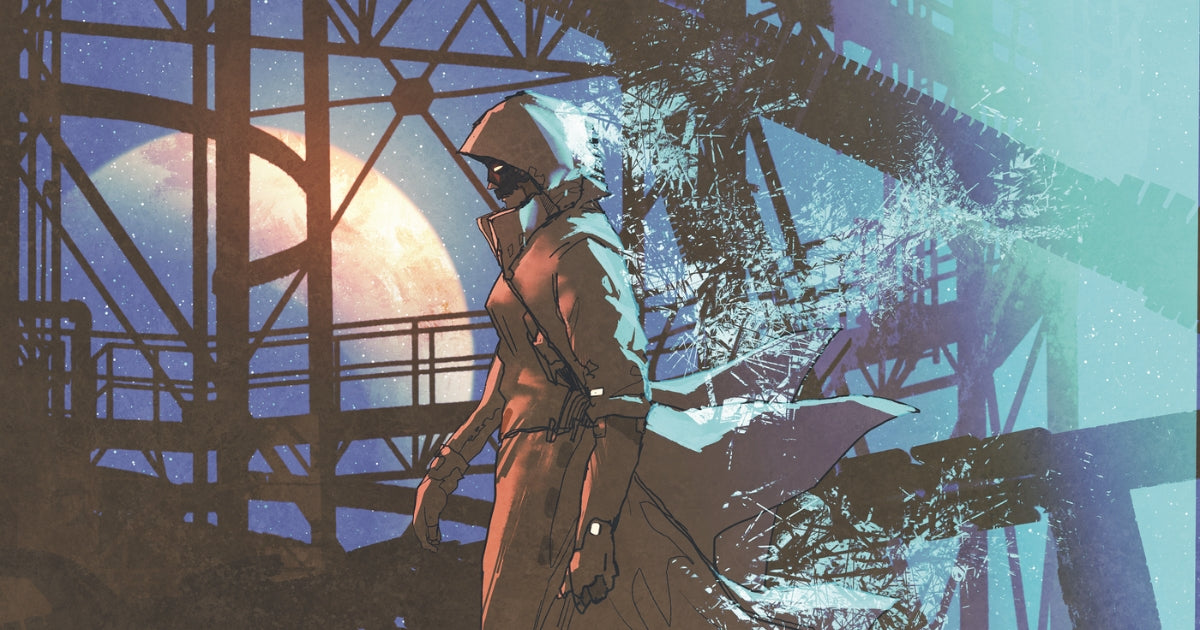

The Last Miner
By Tom Jolly
Audio Narration by Aaron Sinn
Each day at the same time, PM12 beamed a signal at Earth to update its status. It didn’t stop working to perform this task.
Sometimes, there was a response.
“Hello?” it heard. PM12’s receiver recognized the data on the signal as an analog voice and interpreted it accordingly. It still had a functional module that let it synthesize English and respond.
“Hello, this is PM12, delivering a status update.”
“Is there someone there?” said a second voice.
“No, it’s just that PM12 robot again with its goddamned update,” said the first voice. “PM12, what’s your status?”
“I have located an asteroid with an adequate iron supply to produce three standard sheets per hour. I would like to request a retrieval and storage ship for units produced.”
“Jesus, PM12, do you know where those damned steel sheets are going? It’s a hundred thirty outside due to all the crap reentering the atmosphere. Can’t you just stop?”
“I would require a supervisor command to stop manufacturing.”
The second voice said, “Ask it if it can make cooling units and send them down. We’re down to our last six units.”
“The only way it’s gonna send something down here is to drop it from orbit. There are no transports. And it doesn’t make cooling units, anyway, it just makes those damned steel sheets. The PM series were all specialized.”
“Christ.”
***
PM12 gave a little pull on the cable connecting the two asteroids. It was enough to get it moving parallel to the cable, drifting upbelt to the next rock.
Steel cables ran like spiderwebs between the asteroids, a result of the fact that the CM series ran out of storage spools over three-hundred years ago and were just spitting the steel cables they fabricated into the space between the rocks, cables some thousands of kilometers long. Some of the old builder drones used to secure the loose cables by welding them to the nearest asteroid, an emergency safety measure until the cables could be retrieved. The cables ran clear around the belt now, making a tenuous stranded ring-world of ropes and rocks. PM12 used the cables for transport whenever it ran out of volatiles for its one remaining engine.
PM12 kept an antenna trained on Earth in case there were new instructions, instructions that it had stopped receiving in 2175. Its AI wasn’t aware enough to give up, like a dog waiting every day on a doorstep for a dead master to come home and give it a pat on the head. It registered the fact that CM5 was still transmitting a repair request every few minutes. PM12 checked its resources as it did every time it received the signal, then decided that it still couldn’t help. CM5 was the only other unit still communicating at all; unfortunately, it wasn’t smart enough to figure out that no help was coming when it stopped functioning in 2239.
PM12 approached the next asteroid and pulsed it with its remaining operational power laser to vaporize the surface, then ran a quick spectrographic analysis on the vapor. This asteroid tasted good; plenty of iron. Enough impurities to make the ore easy to crush. Enough volatiles to replenish the engines. The tools it used to have to mine pure iron asteroids had worn out over twenty years before; it avoided those now in favor of the rocky S-types that could be pulverized easily.
It fired a bolt into the asteroid and pulled itself in, pressing a canopy onto the surface to contain the mining debris. Sunlight illuminated the inside of the shaft through dozens of unrepaired holes in the canopy. Pounding, crushing, and grinding, then separating the ferrous materials out of the powder with electromagnets, PM12 chewed at the asteroid. Its 3D laser-sintering station built up another steel plate for one of the colony structures, ten meters wide, a centimeter thick, and pushed it out into the vacuum, a new plate every twenty minutes. The storage racks for the plates had been full for centuries, and the drones that transported them there were long gone. The plates drifted loose, giant dull mirrors reflecting the pitted faces of asteroids. The belt glittered like a thin diamond ring in the harsh light of the sun, a thin halo of millions of tiny, flickering, dancing reflections.
As much as its programming could provide, it felt a degree of satisfaction as it worked. Purpose, fulfilled.
None of the other PMs were still functioning; it was the last. The gas laser finally sputtered once and died after it had extracted only 152 panels from the asteroid. PM12 ran a diagnostic on the unit and found a microcrack in the tube. It would have felt some amazement at the fact that the laser had lasted over a hundred years, and that the sintered-metal printer head had never failed during that time, if it had been smart enough to recognize its own fallibility. When the replicators were still functioning, PM12 would have had plenty of replacement parts and would have returned to Earth orbit for repairs. But the replicators lost their production regulation function to an SEU, a single-event-upset, an energetic ion that damaged the code that allowed the units to accurately reproduce. Instead, like cancerous cells, the manufacturing robots filled Earth orbit with so many spares that the eventual and inevitable collision-cascade resulted in a heavy steel rain on Earth that lasted over thirty years before it tapered off to a steady hot drizzle of metallic debris, billions of tiny particles reentering the red, glowing skies. All the parts that could have kept PM12 running ended up in steaming craters, in the deserts, oceans, burning forests, and cities.
The replicators had long since consumed one another, the last few giving up their final years scavenging parts from the residue of the Earth-orbit collision cascade, eventually succumbing to the kinetic cloud of orbiting debris themselves, unobserved balls of flame streaking across the smoky gray skies.
PM12 checked its repair package again, devoid of crawler repair bots after so much time, and considered whether it should return to Earth orbit for repairs but found an emergency message from a hundred years before that warned bots away due to the hazardous conditions there. Since the warning had not been rescinded in those hundred years, PM12 assumed correctly that it was still valid. It extended its antenna and added its voice to CM5’s, beaming past the Earth-Sun L4 point where a dozen ten-kilometer-long dead colonies bumped slowly into one another, vast momenta tearing walls like tissue, pure metal in vacuum, hollow testimonies to man’s engineering prowess, empty reminders of his frailty.
***
“Hello, this is PM12 with a status update.”
“It’s the damned robot again. What’s your status, PM12?” asked the voice.
PM12 recognized the voice pattern. “My last gas laser is no longer functioning and I’m unable to produce any more products. The tube is defective, part number 31-1190-107. I will require a replacement as soon as possible to continue production.”
There was silence for a full minute. Then one man said, “Well, it’s the last one. CM5 isn’t working either. At least there won’t be more shit reentering. Maybe it’ll cool down in the next few years.”
“You think our AC will last that long?”
“Guess we’ll find out, won’t we?”
“This is PM12. Do you have an estimated time of arrival for the replacement part?”
“Sorry, PM12, we don’t have any parts for you. You’re just going to have to shut yourself down.”
PM12 processed their response, then replied, “Initiating subroutine for salvage operations on other damaged PM units.”
“No, wait, PM12, we just found a replacement tube! It was listed in the wrong inventory.” The voice was panicked and rushed. PM12 took a few extra seconds to interpret the slightly garbled message.
“Do you have an estimated time of arrival for the part?” P12 queried again. It could hear the two humans arguing together in the background, but the audio was below its minimum interpretation threshold, and it treated the signal as noise.
“Um, twenty years?” the first voice finally replied.
“August 9th, 2266. Scheduled arrival for replacement part.” PM12 transmitted its coordinates.
“Why didn’t you just tell it a hundred years?” the second voice grumbled. “Hell, two hundred, even.”
“I didn’t think it would believe me.”
“It’s a damned robot, Bill. It’ll believe anything you tell it.”
PM12 tried to interpret the conversation, but humans babbled nonsense sometimes. And it could tell, at least, that the conversation was not directed toward itself, but between the two men. It ignored it.
In the meantime, it had protocols to follow. It was guaranteed a
replacement laser in twenty years, but there would be little to no cost for it to start a salvage operation for a new tube, and potentially great returns. There were several other non-functional PM units within five years of travel that might be cannibalized for parts. With some planning, it might even be closer to Earth when the spare was sent.
It was good to have a purpose.
Copyright © 2021 Tom Jolly
The Author

Tom Jolly
Continue reading

Subscribe to our newsletter
Promotions, new products, and sales. Directly to your inbox.



